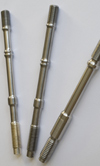Lock and Load
 In the recent Race Engine Technology magazine article on the subject of fasteners, Wayne Ward touched on the subject of locking nuts and locking thread inserts. There are a great many applications where the loss of a fastener is not critical to the operation of the system as a whole; indeed it is common to build in a certain level of redundancy into a bolted or riveted joint for loss or failure of fasteners and the accompanying loss of pre-load. Again, even in this situation, the physical loss of the fastener is again rarely critical. In this article we shall look at some of the implications of losing a fastener.
In the recent Race Engine Technology magazine article on the subject of fasteners, Wayne Ward touched on the subject of locking nuts and locking thread inserts. There are a great many applications where the loss of a fastener is not critical to the operation of the system as a whole; indeed it is common to build in a certain level of redundancy into a bolted or riveted joint for loss or failure of fasteners and the accompanying loss of pre-load. Again, even in this situation, the physical loss of the fastener is again rarely critical. In this article we shall look at some of the implications of losing a fastener.
There are, in the case of racing engines, a number of applications where the physical movement of a fastener from its design location can be disastrous. At this point we should note that if a fastener of any description, be it a nut, bolt or screw has moved from its preloaded position, the joint has failed already. This doesn’t necessarily mean the nut will fall off the bolt or the bolt fall out of a tapped hole. Any physical movement implies loss of preload and we know that correct preload is important in preventing fatigue failures of the fastener.
The ability of the joint and the system as a whole to cope with the loss of preload in any single fastener is a function of the amount of redundancy in the system. Safety-critical applications necessarily carry the penalties of a greater level or redundancy. These penalties are generally, in the case of bolted joints, higher component costs, higher assembly costs and greater weight. The racing engine in general has a much lower level of redundancy than many pieces of machinery because we value light weight, and so when we lose pre-load in a fastener in many race engine applications, we might reasonably expect serious damage to follow.
The obvious applications where, having a fastener rattling around unrestrained, are likely to cause a subsequent failure which is quite separate from any effect due to loss of preload in the joint. In fuel injected engines running an intake plenum, it is common to have quite a lot of hardware in the plenum, such as fuel rails and injectors, and commonly intake trumpets are held in place by small threaded fasteners - although I have seen two very different methods of fastening these which allows quick changes of intake length without the need for threaded fasteners. A loose fastener in the plenum has the possibility to be swallowed by the engine and ingestion of a screw can cause catastrophic valve and piston failure, a miserable end to a race day and a big bill.
Another application where loose screws are dangerous is in the crankcase. In many race series, people look to minimise the frictional losses in the crankcase due to oil-shear by trying to keep, as far as possible, the oil and the rotating pieces apart. This often involves the fitting of various scrapers and screens etc. and these are often held in place by small fasteners. Whilst in many wet-sump applications, this might not be critical, dry sump engines may suffer serious damage.
Written by Wayne Ward.